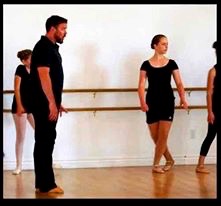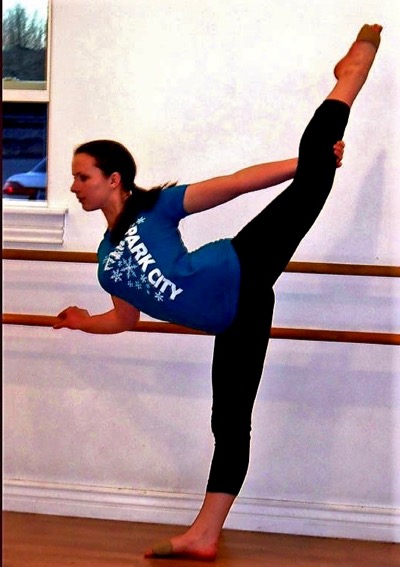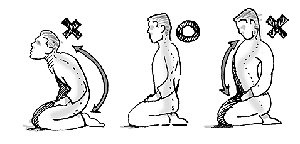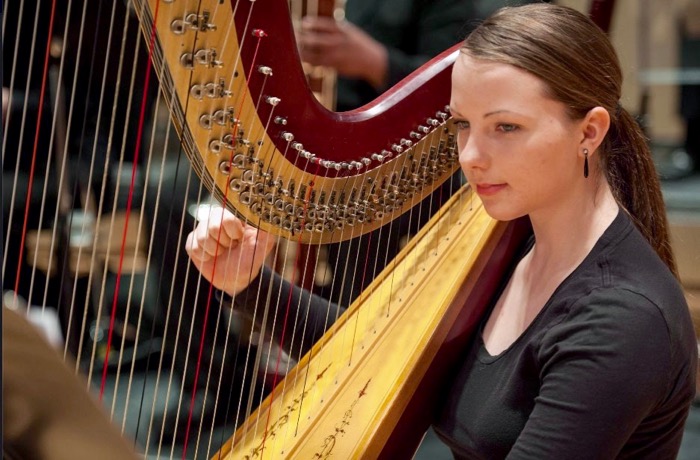I’m excited to welcome guest author Sarah Close to Writing and Wellness. Sarah plays the harp in the local symphony orchestra and other various musical groups. In addition to admiring her skill with the instrument, I have found myself on more than one occasion amazed by her posture. She sits perfectly straight and tall while she plays, and she’ll do that for a couple hours at a time, throughout the entire rehearsal. Considering how difficult it is for writers and other folks who work at the computer all day to avoid slouching, I asked for her advice to help us all to sit up taller and hopefully reduce our risk of neck, back, and hip pain in the process.
by Sarah Close
I have been playing the harp since I was four years old.
I grew up hearing my sister play the harp and immediately fell in love with it. She instructed me until the age of eight when I began taking private lessons.
The harp is one of those instruments that is completely unique in both sound and style. It is a very big instrument, weighing up to 85 pounds, and therefore is not as easy to carry around as a piccolo. The size of the instrument alone is an important reason to maintain good posture.

My First Introduction to Good Posture Occurred in Ballet Class
When I was born, I was almost diagnosed with spina bifida. The doctors told my parents that I had a deep dimple in my back and if it had gotten any worse I could have almost had it.
Although I ended up not having spina bifida, my parents noticed I did have some balance issues as I got older. In order to help solve that problem they put me into ballet. That was my earliest memory of becoming aware of my balance and good posture.
I did ballet for nine years off and on, and it became my greatest source of knowledge for posture awareness.
Why Good Posture is Important for Harpists and Writers
As a harp player, I have found that good posture is very important. When you lean an 85 pound instrument back you have to find the right balance point so it rests lightly on your shoulder.
Being able to sit straight makes it easier for me to play for longer periods of time without getting as tired.
Good posture keeps me alert, focused, and confident as well. I have found that having good posture is not just important as a harpist, but also an important aspect of physical and mental health.
 Keep Your Derriere Tucked and Your Back Straight
Keep Your Derriere Tucked and Your Back Straight
Growing up I have always made sure to have good posture, and a lot of that had to do with ballet. People say you can tell a dancer by the way she walks, and I think there is some truth to that as I have had several comments on my posture, especially when playing the harp.
As a young girl, my teachers were always telling me to keep my derriere tucked, my back straight, and my head looking forward. If I did not do these things, I could seriously injure myself while trying to do a spin or complex leap.
Over time those things became a part of me. However that is not to say it came effortlessly. Maintaining good posture does take work.
How to Maintain Good Posture When You Get Tired
Getting tired is definitely natural. When we get tired we naturally cave in a bit. Our back slumps, our chest goes inwards, our stomach is out, our shoulders go forward and our head is down.
But there are ways to help these things when you do get tired.
- Being aware: The biggest thing for me is just being aware of it—being conscious of those signs and altering them. A lot of the process is mental, so if I start feeling myself slump a bit I sit up. It’s a process of mind over matter.
- Taking breaks: Sometimes it’s hard at a rehearsal or other jobs when you have to sit for one-to-two hours on end. So whenever I get the chance I try to stand up, stretch, and walk around a bit.
- Building stamina: It takes time to build up the muscles required to sit up straight. But the benefits are well worth it. Over time the more you sit up straight the less tired you will get and the more natural it will become. Exercising can help you build up strength and give you better balance for good posture as well.

Good Posture is a Body Language in and of Itself
Over time, I have found that good posture has not only helped me while playing the harp, but it has also helped me in a professional atmosphere.
When you are slumped over, that is a tired, closed in position. When your back is straight, on the other hand, your chest is forward, and your head is held high, that is a confident, open position.
I have found that when I go up to people in this position compared to when I am slumped over, it gives off a more professional and can-do aura.
At competitions, I have also noticed that people with good posture are more likely to win as they aren’t closed off and look practiced.
Good posture is a body language in and of itself.
I have also found that maintaining good posture helps me feel confident and less tired myself. I would challenge you to try to become aware of how you feel mentally when you are slumped compared to how you feel when you sit up straight. See if you notice the difference.
 The Japanese Technique for Sitting with Good Posture
The Japanese Technique for Sitting with Good Posture
I have taken online education since second grade, so I have completed nearly my entire school life at a desk with a computer every day.
I will admit that I have easily fallen into bad posture; it is not a hard thing to do. I did notice, though, how my back hurt so much worse when I went to bed at night after I had been slouching that day.
In middle school, I became really interested in Japanese culture and noticed how they had certain posture techniques. One of their most famous ones is called “seiza.” Often used in martial arts, the person kneels down and sits with their calves tucked under their thighs so they are sitting on their heels and their toes are pointed.
Their back is straight and their heads are straight forward, their hands resting in their laps. It is a well mannered formal position and was believed to be used as a position where you could be calm and thoughtful while still maintaining an alert mind and body.
Although this posture is no longer widely used as it can cause discomfort in the legs, the basic principle of controlled posture remains the same. So the question is, how do you maintain a controlled posture?
How Writers and Other Desk Jockeys Can Find Their Best Posture
In ballet and dance there is something that we call our “center” or “core.” Imagine a string being attached to the top of your head and going straight down through the center of your body.
Now relax your shoulders, and imagine that string pulling you up till you can imagine a straight line going all the way down your body. Notice how you are now sitting or standing up straight, everything is aligned, your chest is forward and your back is straight with your shoulders relaxed at your side. Notice that your pelvis is neither leaning forward nor backward.
This is your centered position of balance and posture. So if you find yourself slumping, pull on that imaginary string to align yourself again.
Where is Your Chair Positioned?
One quick personal tip I have found if working at a desk is to make sure your chair is not too HIGH.
If your chair is too high, you will naturally find yourself slouching so you can rest your arms on your desk. If your chair is moveable, lower it to a position where you are sitting up straight and are able to look at your computer without bending your neck excessively.
Good Posture Promotes Physical and Mental Health
In the end, good posture is not only important to a harpist, musician, or worker, but it is also important in maintaining physical, mental, and emotional health.
With small and steady steps, maintaining this posture will become easier and lead to better habits in and out of the work place.
* * *
Eastern Idaho local Sarah Close is an award-winning harpist who started at age four. Since the age of 12, she’s performed for over 32 conductors and won three concerto competitions as well as taking place in several solo competitions including the American Harp Society National Competition.
She’s currently a member of the Idaho Falls Symphony and Idaho Falls Opera Theatre. She has also received multiple awards for her service in the community including the Congressional Award for over 500 hours of volunteer service. Graduated two years early at 16, she is currently a Phi Theta Kappa, President’s list sophomore in college.
Sources
“Seiza Correct Sitting,” http://www.nantanreikan.ca/Glossary/S/Seiza/seiza.html.
http://www.nantanreikan.ca/Glossary/S/Seiza/seiza3.gif
Chyi Lee, “Seiza: the Traditional Japanese Sitting Posture,” DavidAppleyard.com, 2007, http://www.davidappleyard.com/japan/jp67.htm.


Hi, Sarah and Colleen. Well, this is one of my main problems. When I was a kid, I did have a slight irregularity on my spine, due to wrong sitting positions. Then I had ballet classes too, for about seven years and that changed a lot of things. Recently I went down again and I had the chance to see and experience all the consequences of a bad posture, Sarah. It is all so true.
Thanks for sharing your experience, great article.
Eeek! I know this, but I am SO busted. This is a true nemesis of mine, and man, does my back ever tell me about it. But at least for right this minute, I’m sitting up straight while I type this.
Thank you–I needed this!
You are so very welcome! It is definitely a challenge to maintain sometime, and that’s okay! Small and simple steps are the way to go 🙂 I’m glad I could help!
Great post, Sarah. Thank you for sharing. I have a lot of back issues after getting a spinal injury playing rugby many years ago, some I’ll be trying some of your excellent suggestions out.
Wonderful! So glad I could help with that! 🙂
Excellent article. Thank you Sarah.
You are very welcome! 🙂
I appreciate the advice. These are great tips that need repeating. Posture is important and easy to overlook.
It really is isn’t it? It’s easy to forget especially when it’s been a long day and you are focused on something else. But with repeated steps soon better habits can form 🙂
Thanks for the tips, Sarah. My mother taught me the string technique but I’ll admit I’ve not practiced it as much as I could.
One trick I learned from my kids – wiggle. There is a tendency as we get older to sit very still but if we change it up, there is less tendency to get stiff. So I change my position, keyboard, etc. As you suggest, getting up and moving around is very good too.
I also use an arm chair with arms at the right height to promote good posture. The tendency to lean wrists on the desk can cause trouble. By having the hands and wrists free-floating, there is more wiggle room.
I also wonder if your hand techniques have given your strength there. I was a drummer when younger and developed strong hands – something that helped sitting at a keyboard. Again, that points to the value of variety.
Love the harp, btw.
Thanks for posting this, Colleen
Thanks, David. Some good additional tips. :O)
That is a really great trick David! I can see how wiggling a bit can definitely help from naturally slouching after a while. I will have to remember that! Thank you! 🙂
Thank you, Sarah, for sharing your tips on maintaining good posture. Most helpful!
You are most welcome! Glad I could help! 🙂
Very interesting article.all great points to help with anyone’s posture.i really enjoy your blog
Thanks so much, Don! Sarah has some great tips. :O)
Thank you! It was such a treat to be able to be invited to write for Colleen. I’m glad I could share some helpful tips 🙂